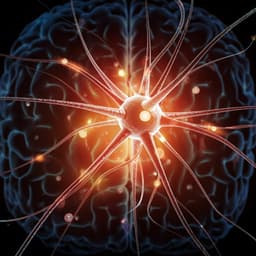
Biology
Myofiber necroptosis promotes muscle stem cell proliferation via releasing Tenascin-C during regeneration
S. Zhou, W. Zhang, et al.
Discover how myofiber necroptosis plays a pivotal role in muscle regeneration! This groundbreaking research by Shen'ao Zhou, Wei Zhang, and colleagues reveals that necroptotic myofibers are essential for effective muscle recovery, releasing factors that stimulate muscle stem cell proliferation. Dive into the unexpected benefits of necroptosis in enhancing muscle healing.
~3 min • Beginner • English
Introduction
The study investigates whether necroptosis, a regulated necrotic cell death pathway driven by RIPK1/RIPK3 and executed by phosphorylated MLKL, occurs in skeletal myofibers after acute injury and whether factors released from necroptotic myofibers benefit regeneration. While necroptosis is often linked to inflammation via DAMP release, its potential beneficial role in tissue repair remained unclear. Skeletal muscle regeneration depends on activation, proliferation, and differentiation of muscle stem cells (MuSCs; Pax7+ satellite cells) situated beneath the basal lamina and adjacent to myofibers. The authors hypothesize that injured myofibers undergo MLKL-dependent necroptosis, which modulates the MuSC niche by releasing pro-regenerative factor(s) that promote MuSC proliferation and thus facilitate regeneration.
Literature Review
Background literature establishes: (1) Necroptosis signaling is mediated by RIPK1-RIPK3 complex formation and downstream MLKL phosphorylation and oligomerization, leading to membrane disruption and DAMP release. MLKL phosphorylation is a widely used in vivo marker of necroptosis. (2) Mlkl- and Ripk3-deficient mice develop normally, indicating necroptosis is dispensable for development but implicated in inflammatory states. (3) Muscle regeneration proceeds through myofiber degeneration (histologically necrosis-like) followed by MuSC activation and differentiation via MRFs (Myf5, MyoD, MyoG, MRF4). (4) EGFR signaling promotes proliferation/asymmetric division in MuSCs and is expressed during activation, while EGF can stimulate proliferation in various cell types. The literature thus frames the gap: whether myofiber death is bona fide necroptosis and whether necroptotic myofibers beneficially shape the MuSC niche via secreted factors.
Methodology
- Mouse models: Generated Mlkl−/− mice via CRISPR/Cas9; used Ripk3−/− mice; created skeletal myofiber-specific Mlkl knockout (MCK-Cre; Mlklfl/fl) and myofiber-specific Tnc knockout (MCK-Cre; Tncfl/fl) mice. Recipient Rag2−/−; Il2rg−/− mice used for transplantation assays. Male mice aged 8–10 weeks unless specified.
- Injury models and treatments: Induced acute tibialis anterior (TA) muscle injury by cardiotoxin (CTX) or BaCl2 injections. Pharmacologic inhibition with Nec-1s (RIPK1 inhibitor) or z-VAD-fmk (pan-caspase inhibitor) delivered intramuscularly. In vivo neutralization antibodies (anti-TNC, anti-EGFR/Cetuximab, anti-EGF) injected intramuscularly post-injury.
- Histology and staining: H&E on cryosections to assess regeneration (myofiber CSA, fusion index). Immunofluorescence for MYH3, Laminin, Pax7, Ki67, MyHC; immunohistochemistry for p-MLKL and TNC. In vivo PI staining for necrosis, EdU incorporation for proliferating MuSCs.
- MuSC isolation and analysis: Enzymatic digestion of muscles, FACS-based isolation/quantification of MuSCs (gating on PI−/7-AAD− CD45− CD11b− CD31− Sca1− Vcam+; and Integrin-α7+ subset). Ex vivo culture in F-10-based media; BrdU incorporation and cell cycle analysis by FACS; differentiation in 2% horse serum.
- Cell lines and death induction: Established C2C12 TetON lines for necroptosis (overexpressing MLKL S345D/S347D-HA-3xFlag) and apoptosis (overexpressing tBid-HA-3xFlag). Induced with tetracycline (1 μg/mL) to generate necroptosis-conditioned medium (NCM) and apoptosis-conditioned medium (ACM). Assessed necroptosis by SYTOX Green uptake and ATP loss; apoptosis by Annexin V/7-AAD.
- Biochemical purification: Collected 2 L NCM, clarified by ultracentrifugation, fractionated by ammonium sulfate (0–30% cut active), followed by Mono-Q anion exchange chromatography. Active fractions analyzed by SDS-PAGE and silver staining; bands identified by mass spectrometry.
- Genetic perturbations: Tnc knockout in C2C12-MLKL-TetON via LentiCRISPRv2; rescue by retroviral TNC re-expression. AAV-mediated CRISPR of Egfr in Cas9-expressing MuSCs. Confirmation by immunoblot/qPCR.
- Recombinant protein studies: Purified GST-tagged mouse TNC fragments (1–700 aa containing assembly + EGF-like domains; and 156–700 aa EGF-like domain) from E. coli; size-exclusion chromatography to assess oligomerization states. GST pull-down with MuSC lysates to test EGFR binding. EGFR pathway activation assessed by immunoblotting for p-EGFR, p-MEK1/2, p-ERK1/2 with/without Afatinib (EGFR inhibitor).
- Transplantation: Expanded Tomato+ MuSCs in NCM or F-10, transplanted into irradiated, CTX-injured Rag2−/−; Il2rg−/− TA; engraftment quantified by Tomato+ myofibers within Laminin boundaries after 28 days.
- Statistics: Two-tailed unpaired t-tests (with or without Welch’s correction), one-way or two-way ANOVA with appropriate post-tests; data reported as mean ± SD; biological replicates and n detailed in figure legends.
Key Findings
- Necroptosis occurs in myofibers after acute injury: RIPK3 and MLKL proteins are upregulated from day 1 post-injury and decline by day 7; apoptosis markers (FADD down, no cleaved caspase-3) do not indicate apoptosis activation. p-MLKL staining appears in injured WT but not Mlkl−/− muscles; abolished by Nec-1s.
- Necroptosis is required for muscle regeneration: Mlkl−/− mice show disorganized muscle and ~50% reduction in average myofiber CSA at 7 dpi, and reduced fusion index at 15 dpi versus WT; similar defects with Nec-1s and in Ripk3−/− mice. MYH3+ nascent myofiber sizes are significantly smaller in Mlkl−/−; MyoD and MyoG levels reduced in regenerating Mlkl−/− muscles.
- MuSC proliferation is impaired without myofiber necroptosis: Post-injury Mlkl−/− muscles have significantly fewer MuSCs by FACS; fewer Ki67+/Pax7+ MuSCs; reduced Ccnd1 mRNA. Freshly isolated Mlkl−/− MuSCs proliferate/differentiate normally ex vivo, suggesting a niche defect.
- Myofiber-specific deletion confirms requirement: MCK-Cre; Mlklfl/fl mice phenocopy global Mlkl−/− with reduced nascent myofiber CSA (7 dpi), reduced fusion index (15 dpi), clusters of death-resistant myofibers, loss of p-MLKL signal, decreased MuSC numbers, reduced MuSC Ccnd1 mRNA; fewer PI+ necrotic cells; reduced EdU+ MuSCs; defects replicated with BaCl2 injury.
- Necroptotic cells release pro-proliferative factors: NCM (from necroptotic C2C12-MLKL-TetON) increases MuSC numbers to ~3-fold over F-10 after 48 h; ACM does not. BrdU incorporation and proliferation increase with NCM. NCM-expanded MuSCs retain Pax7hi state, differentiate into MyHC+ myotubes, and show superior in vivo engraftment versus F-10-expanded cells.
- Active factor(s) are proteinaceous: Trypsin abolishes NCM activity; DNase/RNase do not.
- Biochemical purification identifies Tenascin-C (TNC): Active 0–30% ammonium sulfate fraction eluting at 0.1–0.3 M KCl contains a 250 kD band identified as TNC (along with FBS components and actin). TNC is specifically present in NCM by immunoblot.
- Genetic validation of TNC: Tnc knockout in C2C12-MLKL-TetON abolishes NCM’s pro-proliferative effect; re-expression of TNC rescues it fully.
- TNC expression/release is necroptosis-dependent: Upon MLKL-induced necroptosis, cellular TNC rises and is released extracellularly coincident with membrane rupture (GAPDH release, SYTOX positivity). In vivo, TNC is undetectable in uninjured muscle, but induced in WT injured myofibers; induction fails in Mlkl−/− and MCK-Cre; Mlklfl/fl.
- Myofiber-derived TNC is required in vivo: MCK-Cre; Tncfl/fl mice have fewer MuSCs at 3 dpi, and impaired regeneration with reduced myofiber CSA at 7 dpi.
- Mechanism: TNC (1–700 aa; assembly + EGF-like domains) is sufficient to promote MuSC proliferation, maintain Pax7hi state, and support differentiation and engraftment. GST-TNC(1–700) binds EGFR from MuSCs; induces EGFR phosphorylation blocked by Afatinib. NCM activates p-EGFR, p-MEK, p-ERK in MuSCs; this is lost with TNC-deficient NCM or EGFR inhibition. Neutralizing antibodies against TNC or EGFR, but not EGF, block NCM-induced MuSC proliferation. AAV-CRISPR Egfr knockout in MuSCs reduces proliferation response to NCM. In vivo, p-EGFR colocalizes with Pax7+ MuSCs after injury in WT but not in Mlkl−/−. Blocking TNC or EGFR in vivo impairs regeneration (reduced CSA), while anti-EGF has no effect; endogenous EGF is undetectable in TA pre- and post-injury.
- Structure-function: The TNC assembly domain promotes multimerization of the EGF-like domain, required for EGFR activation; the EGF-like domain alone (156–700 aa) does not oligomerize efficiently, does not activate EGFR, and does not stimulate proliferation.
Discussion
The findings demonstrate that myofiber necroptosis is a programmed event after acute muscle injury and exerts a beneficial role by remodeling the MuSC niche. Necroptotic myofibers upregulate and release TNC, which functions as an EGF mimic via its N-terminal assembly and EGF-like domains to bind and activate EGFR on MuSCs, triggering MEK/ERK signaling and promoting MuSC proliferation. This dual role of necroptosis—clearing damaged myofibers while providing pro-regenerative cues—contrasts with its classical pro-inflammatory reputation and distinguishes it from apoptosis, which has separate roles (e.g., promoting myoblast fusion at later stages). Detection of necroptosis markers (p-MLKL) may aid in assessing regenerative responses after muscle trauma. The work also indicates that necroptotic remodeling of the extracellular milieu can act independently of immune cell infiltration, as NCM recapitulates effects in vitro. Contextually, necroptosis may contribute differently in chronic myopathies (e.g., DMD), where its role in myofibers and MuSCs remains debated, underscoring the importance of injury context. Transcriptional programs (e.g., JAK/STAT, NF-κB, SP1/STAT1/CDK9) known to regulate RIPK3/MLKL in other settings may underlie necroptosis component induction in myofibers, and necroptosis-triggered regulation of TNC gene expression requires further elucidation.
Conclusion
This study establishes that MLKL-dependent necroptosis of myofibers following acute injury is necessary for effective muscle regeneration by promoting MuSC proliferation. Necroptotic myofibers transiently express and release Tenascin-C, which oligomerizes via its assembly domain to act as an EGF mimic, directly engaging EGFR on MuSCs and activating MEK/ERK signaling. Genetic and pharmacologic perturbations in mice and biochemical assays pinpoint TNC as the essential pro-proliferative factor in necroptosis-conditioned medium. These findings redefine necroptosis as a beneficial driver of niche remodeling in skeletal muscle repair. Future directions include: dissecting transcriptional mechanisms coupling necroptosis to TNC upregulation; identifying additional necroptotic factors shaping the MuSC niche; determining whether similar necroptosis–stem cell activation axes exist in other tissues; and clarifying roles in chronic muscle diseases.
Limitations
- Mechanism upstream of TNC induction is unresolved: how necroptosis signaling transcriptionally upregulates Tnc in myofibers is unknown.
- Additional factors may contribute: purification focused on TNC, but other necroptotic cargoes could aid MuSC proliferation or other regenerative phases.
- Context dependence: conclusions are based on acute injury models (CTX, BaCl2) in mice; roles in chronic myopathies (e.g., DMD) and across species require validation.
- In vitro systems: C2C12 overexpression-based necroptosis and recombinant protein assays may not capture full in vivo complexity of ECM interactions and cell–cell communication.
- EGFR pathway specificity: although EGF was undetected and EGFR blockade phenocopied defects, potential contributions of other EGFR ligands or receptor family members were not comprehensively excluded.
Related Publications
Explore these studies to deepen your understanding of the subject.







